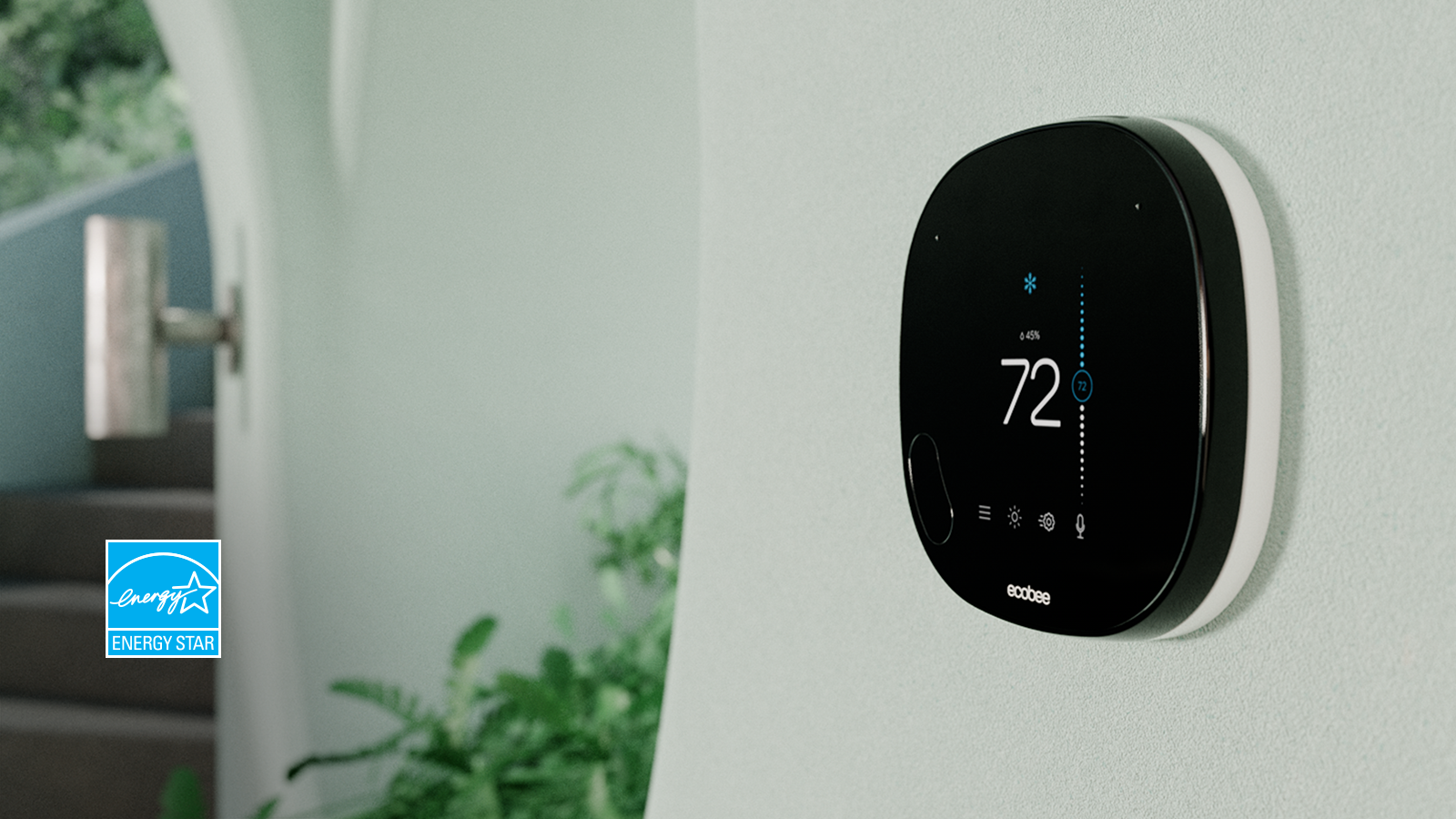How ecobee and ENERGY STAR Set the Standard for an Industry
by ecobee on 10/27/2020 in Smart Home & Tech
9 min read

As the creator of the world’s first smart thermostat, ecobee also helped shape the ENERGY STAR certification for smart thermostats released in 2016. The widely recognized ENERGY STAR logo is the government-backed symbol for energy efficiency that offers consumers and businesses alike simple, credible, and unbiased information to make well-informed decisions.
In recognition of the fifth annual ENERGY STAR Day, we looked back at ecobee’s role in helping develop the ENERGY STAR certification for smart thermostats, and how we continue to build on that standard to deliver increased comfort and energy savings for our customers.
We started with the idea that we could help consumers conserve energy, save money and reduce their environmental impact.
To get the full story, ecobee Citizen spoke with two smart thermostat pioneers about their experiences: Stuart Lombard, ecobee’s founder and chief executive officer, and Abigail Daken, who as a product manager and environmental engineer for the Environment Protection Agency (EPA) was a leading force in the creation of the standard.

Looking for a new way to conserve and save.
Before the arrival of the smart thermostat, there was the programmable thermostat.
In theory, programmable thermostats improved on older models by letting homeowners create their own thermostat schedules—keeping you comfortable when you’re home and easing up on energy usage when you’re away.
“But there was a bunch of research suggesting that programmable thermostats were not delivering on their promised energy savings and environmental benefits,” Daken said.
The ENERGY STAR certification is fundamentally important to us because it verifies that our products actually do what they say they do on the box.
She suspects that two of the main reasons why programmable models were proving less effective than advertised is that they’re difficult to use and aren’t controllable over the internet.
It was winter 2007, and ecobee founder Stuart Lombard had recently learned that heating and cooling make up 40% to 60% of home energy use. On a mission to reduce his family’s environmental footprint, Lombard set his programmable thermostat to conserve energy while away on vacation, only to arrive back home to Toronto, and a shockingly cold house.
Lombard began to envision a better thermostat that could conserve energy without compromising comfort. He quickly assembled a team of like-minded technologists and ecobee was born. The fledgling company released the world’s first internet-connected smart thermostat, the ecobee Smart, just a year later, in late 2008.
“ecobee started with the idea that we could help consumers conserve energy, save money and reduce their environmental impact—and do it in a way that was accessible and available to everyone. Because, let's face it, solar panels and electric vehicles, while fantastic technology, are expensive,” Lombard said.
It was clear then that easy-to-use, affordable smart thermostats were the future of home energy conservation. ENERGY STAR stopped certifying programmable thermostats in 2009 and began the search for a better way to recognize thermostats.
ecobee was there with us from the very beginning.

A new star is born.
In 2012, ENERGY STAR began work on developing the standard for smart thermostats. At the time, there were just two established internet-connected thermostat brands, ecobee, and Radio Thermostat being the other.
Daken and her colleagues were quick to notice the potential benefits of smart thermostats, for researchers as well as homeowners.
“The key to smart thermostats is that they give us a window into how they’re used in the home. We don’t have to certify based on how well they performed in a controlled laboratory setting as we did with programmables. With smart thermostats, we can see how consumers are using them, if they’re saving energy, and certify accordingly,” said Daken.
The EPA began working with ecobee and other industry leaders on a multi-year effort to develop the criteria for the ENERGY STAR smart thermostat certification.
“ecobee was there with us from the very beginning,” Daken said. The EPA developed a method for calculating energy savings and sent it out to manufacturers. The standard was set based on the results from ecobee and two other manufacturers.

When aggregated, the anonymized thermostat data ecobee had collected from participating customers’ thermostats showed a clear pattern of energy savings. Because ecobee thermostat data is always anonymized, the company could use it to make a rock-solid case for certification without compromising user privacy.
When the standard was released in December 2016, the ecobee3 was among the first smart thermostats to be ENERGY STAR certified.
“The ENERGY STAR certification is fundamentally important to us because it verifies that our products actually do what they say they do on the box,” said Lombard.

What does ENERGY STAR certified mean to you?
According to its website, “smart thermostats that earn the ENERGY STAR label have been independently certified to deliver energy savings” for optimal heating and cooling performance.
As a consumer, it means you can feel confident in what the technology will deliver, with the unbiased validation that it meets a high-level of performance.
Here are some of the main reasons why ENERGY STAR certified thermostats like those from ecobee are the best choice for most families:

Scheduling
Certified thermostats from market leaders can use onboard occupancy-sensing and geofencing to develop an accurate schedule that automatically adjusts for optimal comfort when you’re home and energy savings when you’re asleep or away.
In addition to saving energy when you’re away, ecobee smart thermostats lower your energy usage when you’re home by operating your system more efficiently.
Compared to homes with older thermostats, ecobee customers save up to 23%* on heating and cooling costs. By enabling eco+, a free software upgrade for ecobee thermostats, ecobee customers save an additional 5% on average.†
Control
The internet connectivity of ecobee smart thermostats makes controlling your home’s comfort from anywhere easy with the ecobee app.
Now, when Lombard and his family take a trip, he can set their home to Vacation Mode before, during, or even after departure.
- While they’re gone, the in-home temperature is automatically set back to a safe temperature for energy savings.
- When they go away in the winter, the Lombards can rest easy knowing they’ll be notified if their HVAC system fails so they can schedule a technician before the pipes burst.
- Instead of coming back to a frigid or scorching home, they’ll be welcomed back to one that’s been perfectly pre-heated or cooled to their desired temperature.
Insight
ecobee thermostats come with a lifelong subscription to Home IQ. Accessible via the customer web portal, Home IQ’s graphs let you visualize how much energy you conserved each month and give you insights into how your home heats and cools.
Software updates
Unlike older model thermostats that just hang on your wall, smart thermostats from leading brands are always getting better. Internet connectivity means the software can be updated to ensure your home is always powered by the latest energy-saving and comfort-enhancing algorithms and features.

Innovation
Innovative companies like ecobee are always discovering new ways to improve their products to deliver more benefits for customers.
For example, in areas where energy prices vary by time of day, an ecobee thermostat with the eco+ Time of Use feature enabled can automatically pre-cool or pre-heat the home when energy is lower-cost and generated from cleaner sources. ecobee users who enable this feature can save 8% to 19% on the HVAC-related charges on their electricity bills.†
In one year, ecobee customers received over $8.6 million in incentives for participating in utility demand response programs.
Another feature from ecobee, eco+ Community Energy Savings (CES), rewards customers for helping their communities when demand on the electrical grid peaks. With CES enabled, ecobee thermostat owners can enroll in their utility’s demand response program with just one tap in the ecobee app.
Once enrolled, CES makes slight, automatic temperature adjustments to your thermostat for brief periods at times of the year when energy demand peaks.
Between Nov. 2019 and Oct. 2020, ecobee thermostat owners received over $8.6 million in cash incentives from their utilities for participating in demand response programs.
“Features likes these are making a really big impact in terms of air quality, grid stability, and in reducing greenhouse gas emissions,” said Daken.

The future is electric.
According to Daken, the next generation of the ENERGY STAR standard for smart thermostats due out in 2022 will be tailored to making more efficient use of electric heat pumps.
Heat pumps are an energy-efficient alternative to furnaces and air conditioners that experts say are vital in the transition to a low-carbon future based on renewables. Most commonly found in milder climates, recent technological breakthroughs make newer models a great choice for colder places.
Refrigerators and air conditioners are both examples of heat pumps that only work in the cooling mode. But the same heat pump technology that keeps things cool can be used to warm you up.

Some heat pumps include a backup or auxiliary heating system that comes on automatically in the following scenarios: when the heat pump isn’t able to heat the home on its own; and when the system is having trouble coming up to a desired temperature quickly.
“In the next version of the specification, smart thermostats will have to show they are able to favor the heat pump over the significantly less efficient [auxiliary system],” said Daken.
For example, if you typically get home at 5pm on weekdays, the thermostat should start pre-heating or cooling the home at 4pm so it can get to the set temperature without having to call on AUX Heat for a quicker response.
The future for smart thermostats is bright. In a few short years the market has spread beyond early adopters to where everybody has to have one.
Lombard says that the same ecobee technology that’s turning homes into batteries for storing low-cost, low-carbon energy is now being adopted to optimize how ecobee thermostats work with heat pumps by minimizing the use of inefficient AUX Heat.
“When you look at solutions like the ones we’re creating at ecobee, there are many reasons to be optimistic. The fact is, in spite of a world of bleak headlines, we are making significant progress to a cleaner, healthier future,” said Lombard.
Daken agrees: “I think the future is bright. In a few short years smart thermostats have captured a significant portion of the market—now they’re spreading beyond early adopters to a place where everybody has to have one.”
Save Today, Save Tomorrow, Save for Good with ENERGY STAR

Learn how you can save money with ENERGY STAR certified products and how to apply those bill savings to the things that matter.
* Compared to a hold of 72°F/22°C.
† Based on a study conducted by a third-party expert during summer 2020 across the US and Canada. Savings vary by season, climate zone and rate structure.
Did you enjoy this article?
Thanks for letting us know!






